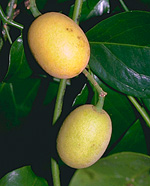 |
This small, pantropical family is represented in Australia by 2 genera, each with 1 species, both found in open woodland and vine scrubs across northern Australia, on light-textured, sandy soils.
Characteristic features of the family Opiliaceae in Australia include: - twining, woody lianes with alternate leaves borne in two rows along stem (distichous), often with cystoliths (crystal bodies) visible as fine tubercles on dried leaves
- flowers small, greenish or cream, in short, axillary spikes or racemes
- perianth 1-whorled, the parts free or fused at base into a bell- or urn-shaped tube; anthers dorsifixed and versatile
- ovary superior, surrounded by a fleshy nectar-disc, and developing into a fleshy, single-seeded, yellow or orange fruit
Description
Evergreen trees, or shrubs, or woody vines climbing by twining stems. Plants partially or totally parasitic on the roots of the host. Internal secretions not obvious. Plants glabrous, or with simple, non-glandular, uniseriate hairs. Leaves distichous, petiolate. Stipules absent. Lamina simple, symmetric, lanceolate, ovate, elliptic or oblong; base cuneate, attenuate or rounded; margins entire, ±flat; venation pinnate, with the midrib conspicuous, and the tertiary venation reticulate or not; surfaces not punctate; herbaceous, leathery or rarely succulent. Usually with all the flowers bisexual, or more rarely with male and female flowers occurring on separate plants. Inflorescences axillary, consisting of catkins, spikes or racemes. Bracts present. Pollination by insects. Flowers odourless or fragrant, sessile or stalked. Floral disc present; nectaries present on the disc. Perianth regular, of 1 whorl only, with 4–5, free or fused, ±petaloid or sepaloid segments, valvate in bud, bell-shaped or urn-shaped, white, yellow or green, without contrasting markings, herbaceous. Fertile stamens 4 or 5, opposite to and free of the perianth, free of the ovary and style, distinct from each other, all ±equal. Anthers dorsifixed, versatile, opening sideways by longitudinal slits, 2-celled. Ovary superior and sessile. Carpel 1; ovary with 1 locule. Style terminal, single and unbranched, or absent with the stigma ±sessile on the ovary. Ovule 1, sessile; placentation apical. Fruit a fleshy indehiscent drupe; the perianth on the maturing fruit ?deciduous, or dry and persistent. Disseminule macro-surface featureless or with straight hairs; micro-surface ±smooth, yellow or orange, glossy. Seeds 1 per fruit. Aril absent. Cotyledons 3 or 4. Embryo straight.
(Note: this description has been generated from the coded data compiled for the key. Any errors in the key data will be reflected in the descriptions.)
A treatment of the family Opiliaceae has been published in:
Flora of Australia 22: 27-29.
Australian genera of Opiliaceae (as recognised for the Flora of Australia)
Cansjera
Opilia

|
  |

Opilia amentacea (fruits)
Photo: D.Jones © D.Jones
|
 |
|